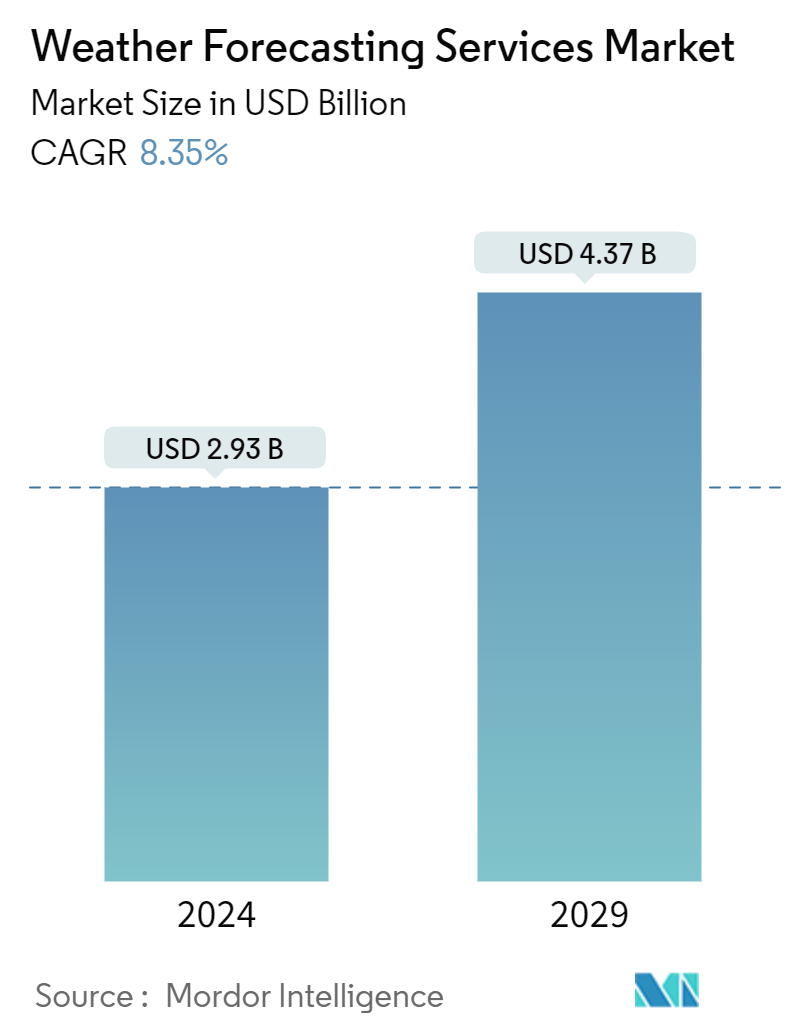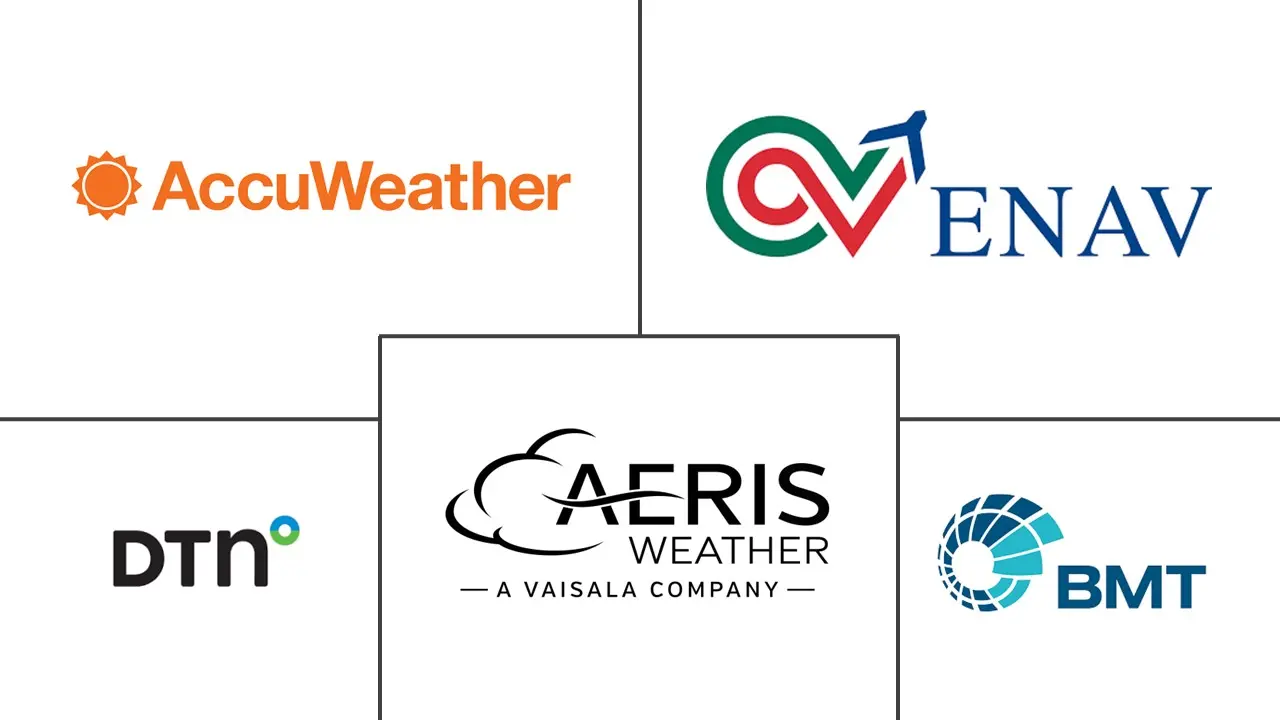Market Size of Weather Forecasting Services Industry

| Study Period | 2019 - 2029 |
| Market Size (2024) | USD 2.93 Billion |
| Market Size (2029) | USD 4.37 Billion |
| CAGR (2024 - 2029) | 8.35 % |
| Fastest Growing Market | Asia Pacific |
| Largest Market | North America |
| Market Concentration | Medium |
Major Players
*Disclaimer: Major Players sorted in no particular order |
Weather Forecasting Services Market Analysis
The Weather Forecasting Services Market size is estimated at USD 2.93 billion in 2024, and is expected to reach USD 4.37 billion by 2029, growing at a CAGR of 8.35% during the forecast period (2024-2029).
The factors expected to drive the growth of the global weather forecasting services market are expanding due to the occurrence of catastrophic events secondary to undesired climatic changes and resulting security concerns. The progressed and authentic weather forecasting accomplished within the stipulated time can prompt significant cost investment funds and help with security against calamities and cataclysmic events. Advanced weather forecasting help to reduce uncertainty like floods, droughts, and other natural disasters. It improved agriculture productivity and was implemented by the industry to track their profitability.
- Weather forecasting services are essential for aviation safety and efficiency. They provide pilots with information about the current weather conditions and forecasts of future conditions. This enables pilots to decide when to take off or land, what route to fly, and how much fuel they need to carry. Weather forecasts also help air traffic controllers plan routes that avoid hazardous weather systems such as thunderstorms or turbulence. In addition, airlines use weather data to optimize their operations by scheduling flights around expected delays due to bad weather. F
- inally, meteorologists use this data to research climate change and other environmental issues. Media and consumer outlets use weather forecasting services to provide accurate information about current weather conditions and predictions for future weather events. This information can be used in various ways, such as helping people plan their daily activities or providing news reports with up-to-date forecasts.
- Facilities for weather forecasting frequently use advanced, energy-consuming devices and infrastructure. Environmental observation information is a subset of big data that has recently increased exponentially. As a result, weather forecasting centers are mandated to provide integrated solutions that manage weather forecasters' computing needs, data transfer and management, and ownership of the whole cost of these operations.
- Additionally, the development of supercomputer processing power is projected to make it more comfortable to integrate a combination of high-resolution weather predictions and climate models, producing extraordinarily accurate and exact forecasts.
- Short-range weather forecasting services provide forecasts of conditions up to two weeks in the future. These services provide detailed weather predictions, such as hourly or daily temperature forecasts, precipitation, wind, and other meteorological variables.
- They are usually based on numerical weather prediction models that use data from weather stations, satellites, and other sources to predict the future state of the atmosphere. Short-range weather forecasting services are used to inform decisions such as when to plant crops, when to schedule outdoor events, and when to take precautions against severe weather.
- On the flip side, since weather conditions vary frequently, weather forecasting models must use contemporary oceanic and atmospheric conditions to resolve future weather. Weather prediction considers humidity, temperature, air pressure, wind speed, and cloud cover. Numerous variables are taken into consideration by weather forecasting models, including latitude and longitude elevation, as well as proximity to water sources, geographic position, and urban constructions.
Weather Forecasting Services Industry Segmentation
Weather forecasting is predicting what the atmosphere will be like in a particular place using technology and scientific knowledge to make weather observations. It is a way of predicting things like cloud cover, rain, snow, wind speed, and temperature before they happen.
The weather forecasting services market is segmented by forecasting type (short-range forecasting, medium-range forecasting, and long-range forecasting), by end user (transportation, aviation, energy and utilities, banking, financial services and insurance (BFSI), agriculture, and other end users), and by geography (North America, Europe, Asia Pacific, Latin America, Middle East, and Africa).
The market sizes and forecasts are provided in terms of value (USD) for all the above segments.
| By Forecasting Type | |
| Short-range Forecasting | |
| Medium-range Forecasting | |
| Long-range Forecasting |
| By End User | |
| Transportation | |
| Aviation | |
| Energy and Utilities | |
| Banking, Financial Services and Insurance (BFSI) | |
| Agriculture | |
| Others |
| By Geography | |
| North America | |
| Europe | |
| Asia | |
| Australia and New Zealand | |
| Latin America | |
| Middle East and Africa |
Weather Forecasting Services Market Size Summary
The weather forecasting services market is poised for significant growth, driven by the increasing frequency of catastrophic events linked to climate change and the subsequent need for enhanced security measures. Advanced weather forecasting plays a crucial role in mitigating uncertainties associated with natural disasters, thereby offering substantial cost savings and improving safety. This sector is vital for various industries, including aviation, where accurate forecasts are essential for flight safety and operational efficiency. The integration of high-resolution weather predictions and climate models, supported by advancements in supercomputer processing power, is expected to enhance the accuracy of forecasts. Additionally, the market is witnessing a surge in demand from the agricultural sector, where precise weather data is indispensable for optimizing crop yields and managing agricultural operations effectively.
In North America, the weather forecasting services market is characterized by intense competition and substantial growth prospects, fueled by technological advancements and increasing demand for weather-based applications. Regulatory support, such as the Weather Research and Forecasting Innovation Act, underscores the importance of enhancing weather research and forecasting capabilities. Collaborative efforts among key players, including partnerships and strategic investments, are driving innovation and expanding market reach. The market is moderately consolidated, with major companies like AccuWeather, AerisWeather, and DTN leading the charge in developing advanced forecasting solutions. These developments are not only improving operational efficiencies across various sectors but also paving the way for new market entrants, particularly in agriculture, where startups are leveraging weather analytics to provide localized insights.
Weather Forecasting Services Market Size - Table of Contents
-
1. MARKET INSIGHTS
-
1.1 Market Overview
-
1.2 Industry Attractiveness - Porter's Five Forces Analysis
-
1.2.1 Bargaining Power of Buyers
-
1.2.2 Bargaining Power of Suppliers
-
1.2.3 Threat of New Entrants
-
1.2.4 Threat of Substitutes
-
1.2.5 Intensity of Competitive Rivalry
-
-
1.3 Assessment of the Impact of COVID-19 on the Market
-
-
2. MARKET SEGMENTATION
-
2.1 By Forecasting Type
-
2.1.1 Short-range Forecasting
-
2.1.2 Medium-range Forecasting
-
2.1.3 Long-range Forecasting
-
-
2.2 By End User
-
2.2.1 Transportation
-
2.2.2 Aviation
-
2.2.3 Energy and Utilities
-
2.2.4 Banking, Financial Services and Insurance (BFSI)
-
2.2.5 Agriculture
-
2.2.6 Others
-
-
2.3 By Geography
-
2.3.1 North America
-
2.3.2 Europe
-
2.3.3 Asia
-
2.3.4 Australia and New Zealand
-
2.3.5 Latin America
-
2.3.6 Middle East and Africa
-
-
Weather Forecasting Services Market Size FAQs
How big is the Weather Forecasting Services Market?
The Weather Forecasting Services Market size is expected to reach USD 2.93 billion in 2024 and grow at a CAGR of 8.35% to reach USD 4.37 billion by 2029.
What is the current Weather Forecasting Services Market size?
In 2024, the Weather Forecasting Services Market size is expected to reach USD 2.93 billion.

